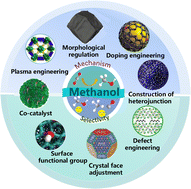Research on photocatalytic reduction of carbon dioxide (CO2) has extensively progressed. Among the photocatalytic CO2 reduction products, methanol (CH3OH) has attracted interest from scientists as an important liquid product. However, during the reduction process, there are significant challenges in terms of the selectivity for realizing CH3OH owing to a six-electron transfer process towards achieving methane (CH4) and inefficient CO2 conversion performance. Hence, this work is focused on the studies related to the product selectivity of photocatalytic CO2 reduction and strategies for the modification of photocatalysts in order to obtain CH3OH. The related photocatalytic selectivity mechanism is introduced, and the strategies to modify photocatalysts for the conversion of CO2 to CH3OH (elemental doping, defect engineering, co-catalyst loading, construction of heterojunctions, surface functional groups, plasma engineering, etc.) are comprehensively described. Finally, the challenges and future development prospects in achieving a higher efficiency and selectivity in photocatalytic CO2 reduction to CH3OH are summarized.
